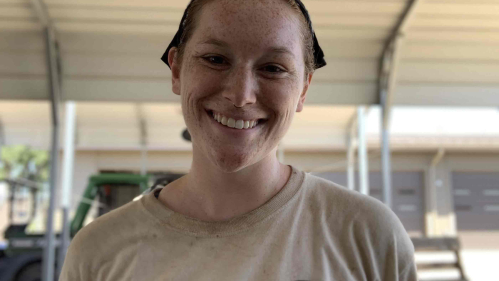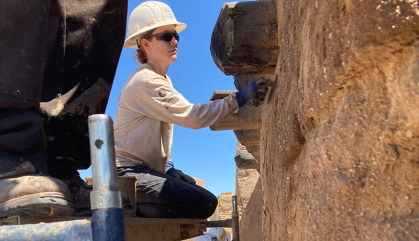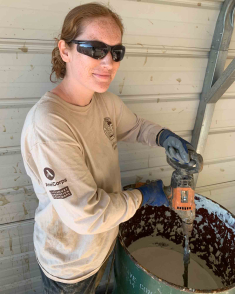Blending Art, Nature and Community Work, Rutgers Grad Uses Prize Money to Fund Tour With AmeriCorps

Johanna Cordasco, who focused on sculpture at the Mason Gross School of Arts, is helping communities and doing conservation work in the southwestern U.S.
Johanna Cordasco enjoys working with her hands.
It’s why the recent Rutgers University graduate was a visual arts major in the Department of Art and Design at the Mason Gross School of the Arts in New Brunswick, N.J., where she concentrated on sculpture.
It’s also why the 23-year-old, who received a community-service award during the Mason Gross commencement-convocation ceremony in May, used her prize money to buy a backpack and fund a trip to Flagstaff, Ariz., where she joined the federally supported service organization AmeriCorps as a crew member for a six-month stint doing conservation and restoration work and helping communities throughout the southwestern U.S.
I’ve always been infatuated by the connection between art and nature, and I’m finding that the skills I learned from sculpture are carrying over a lot.
– Johanna Cordasco
Cordasco – who grew up in Basking Ridge, N.J., where she and her family lived above a bicycle shop run by her father – sought a way to put her bachelor of fine arts degree to work in the center of what she described as a Venn diagram of art, nature and community service.
“In the middle of those three things is where I would like to be,” said Cordasco, who was interested in the AmeriCorps program because she had done trail work at the Rutgers University Ecological Preserve at Rutgers–New Brunswick’s Livingston campus. “I guess I always felt the need to be helpful. I don’t know what that’s rooted in, but it’s gratifying to help others.”

Cordasco was awarded the Scott Cagenello Memorial Prize, an honor given in memory of the late Mason Gross dean of students. The prize is awarded annually to a graduating Mason Gross student who has demonstrated a commitment to helping others in the school and the wider community.
Cordasco – who previously volunteered at America's Grow-a-Row, a produce donation organization in Pittstown, N.J., and the Bernardsville Public Library – initially thought about joining the Peace Corps. Then her friend, who also graduated from Mason Gross, told her about a program in Flagstaff, home of the American Conservation Experience, a nonprofit group that recruits participants to work in national service as AmeriCorps members.
“I was at a point in my life where I wanted to do something, I wanted to go somewhere,” said Cordasco, adding that her mother just sold the family home and is moving to Virginia, where her sister lives and her brother goes to school. “There were a lot of things up in the air, a lot of change going on.”

After a couple of days of orientation in June, Cordasco joined an AmeriCorps crew and got busy making sandbags for underserved communities in Coconino County, where residents feared flooding because of monsoon season and wildfires. (“The fires burn up foliage that would slow the flooding,” Cordasco said.)
After crafting sandbags, Cordasco headed to southeastern Colorado, where AmeriCorps members worked on a restoration effort involving Bent's Old Fort, a fur trading post originally built in the 1840s. The structure is made of adobe (a mix of sand, clay and sometimes straw), the perfect medium for a sculptor.
“I’ve always been infatuated by the connection between art and nature, and I’m finding that the skills I learned from sculpture are carrying over a lot,” said Cordasco, who minored in psychology and art history. “I’m excited to get to work with my hands, be around good people, explore and be a part of something meaningful.”
This can-do attitude is of no surprise to Heather Hart, an assistant professor of sculpture at Rutgers. Cordasco served as her teacher’s assistant.
“She was a cheer squad when a group was feeling burned out, a production manager slash detail person when I was trying to juggle and engage with work and grades and feedback for students, and she was someone who dives in to learn new things quickly and meticulously,” Hart said.
“Johanna has been working through an ethics of materials and craft techniques to create intellectually insightful and personally potent work,” added Jeanine Oleson, an associate professor of sculpture who worked with Johanna over the past three years.
Cordasco said she encourages others to do volunteer work “or just do a job that you think is making a difference.”
“For me, I prefer to be working in the field and working with my hands,” she said. “I think there are ways in life you can work toward your strength, and if you really have a passion, there are usually ways to do it.”


